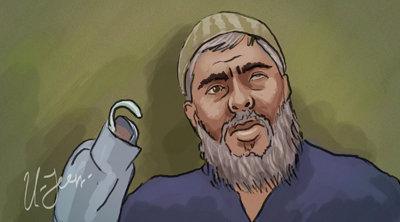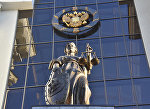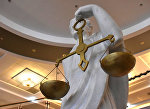MOSCOW, January 30 (RAPSI, Ingrid Burke) – Terror suspect Mostafa Kamel Mostafa, known more broadly as Abu Hamza, moved to preclude US prosecutors from referencing Osama Bin Laden or the September 11th terrorist attacks during the course of his upcoming federal trial in New York.
Abu Hamza faces charges in connection with a 1998 hostage crisis in Yemen, the attempted establishment of a “jihad training camp” in the American state of Oregon, and the support of “violent jihad” in Afghanistan between 2000 and 2001.
A motion filed by Abu Hamza’s defense team Wednesday asserts: “The charges in this case relate broadly to alleged illegal conduct and material support for terrorism, but the charged acts are not alleged to have been connected in any way to the attacks of September 11, 2001, to Osama Bin Laden, or to any of the other individuals involved in the planning and execution of those attacks.”
The motion notes that the 9/11 attacks will remain heavy on the minds of those filling the jury boxes of every terrorism trial carried out in the US for quite some time.
Accordingly, “to allow the government to make specific reference at trial to the events of September 11th, or to Bin Laden or his associates, would completely deprive [Abu Hamza] of a fair trial as to the actual charges and the specific acts that are alleged against him in the instant indictment.”
The defense further seeks the preclusion of video footage, audio files, or photographs featuring acts of violence that are not attributable to Abu Hamza and his alleged co-conspirators, or otherwise connected with the acts charged in the indictment against him.
The motion notes that even material depicting acts of violence relevant to the charges in the indictment should be precluded, “because their unfair prejudicial impact substantially outweighs any probative value they may possess,” or failing that, they may simply constitute “a waste of time.”
Accordingly, if prosecutors seek the introduction of depictions of violence at trial, the defense motion implores the court first to view the evidence privately, then to require the government to explain the relevance and value of the given item, and then to allow the defense team to move for the item’s preclusion or limitation.
Meanwhile, prosecutors moved Monday for an anonymous jury and various other forms of jury protection through the course of the upcoming trial.
Three factors are generally considered within the circuit in making such a determination, according to a memo accompanying the motion: the nature and seriousness of the charges; the potential for corruption of the judicial process – such as through fear of personal safety; and expectations of widespread publicity.
The memo asserts that all three factors in this case weigh in favor of jury anonymity.
With regard to the first factor, the memo notes: “the seriousness of the charges against the defendant and the nature of the conduct underlying those charges will likely raise in at least some jurors’ minds a reasonable fear for their own safety.”
On the second factor, the memo boldly asserts: “Al Qaeda has unequivocally demonstrated, through words and actions, that it poses a threat to the judicial process… And the defendant is alleged to have worked for years to support al Qaeda, by attempting to establish a jihad training camp in the United States and sending one of his followers to Afghanistan to support al Qaeda.”
The memo further states that the trial has already attracted a media firestorm, adding that: “Juror anonymity is an effective remedial measure to prevent possible prejudice and inappropriate contact by the press and others.”
According to the indictment, Abu Hamza conspired with others in December 1998 to take a group of Western tourists hostage in Yemen. The indictment explains: “On or about December 28, 1998, the hostage-takers stormed a caravan of sport utility vehicles carrying sixteen Western tourists and took the tourists hostage by use of force.”
The Yemeni military then attempted to rescue the hostages, at which point the “hostage takers used the hostages as human shields and attempted to fight off the Yemeni military,” according to the indictment. Four hostages were killed and several wounded in the ensuing combat.
The indictment goes on to allege that Hamza conspired with others and provided material support for a “violent jihad training camp” in Oregon. These efforts included, among other things, the stockpiling of weapons and ammunition within the US. The indictment goes on to allege that Abu Hamza’s two co-defendants Oussama Abdullah Kassir and Haroom Rashid Aswat travelled to Bly, Oregon – telling individuals there that “they had been sent there by [Abu Hamza] to train people for jihad and to assess the suitability of the Bly, Oregon property for a Jihad training camp. [Kassir and Aswat] also both told individuals at the property that they supported [Bin Laden] and al Qaeda, and had received their own jihad training in Afghanistan.”
The indictment further alleges in part that Abu Hamza provided and concealed material support and resources to terrorists facilitating violent jihad in Afghanistan, and that Abu Hamza conspired to supply goods and services to the Taliban in violation of the International Emergency Economic Powers Act (IEEPA).
With regard to the latter, the indictment alleges that Abu Hamza posted messages on the Supporters of Shariah (SOS) website urging his followers to donate money, goods, and services to Taliban programs in Afghanistan. This activity is alleged to have occurred between Spring 2000 and at least September 6, 2001.
According to the ECHR judgment, Abu Hamza is a British national and was born in 1958. The judgment goes on to describe his myriad health problems, including: type-two diabetes, high blood pressure, poor vision in his left eye, no vision in his right eye, psoriasis, excessive sweating, and two amputated forearms. He gained notoriety with UK tabloids for the fact that he frequently sported a hook in place of one of his hands. The London Evening Standard reported in March, however, that Abu Hamza had received new plastic prosthetics after having been extradited to the US. The newspaper predicted that the taxpayer-funded prosthetics cost upwards of $15,000.



